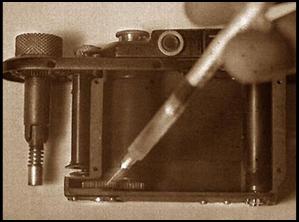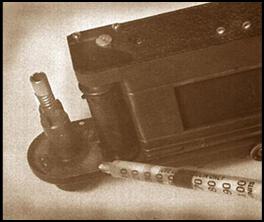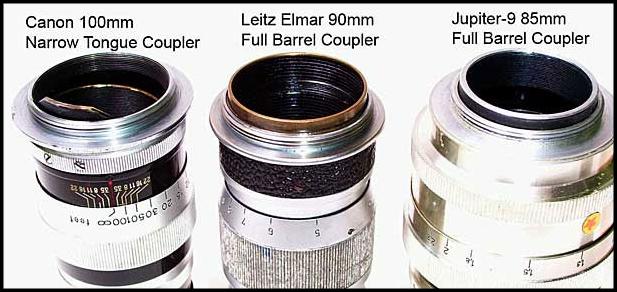
|
Common Bugs page 2 |
|
STIFF WINDING AND FOCUSSING
If winding knob turns roughly or with some difficulty (with an empty camera), the winding gears may be dirty, or as mentioned previously, due to an over-tensed shutter. Some cleaning and lubricating may help. The winding gears can be accessed without disassembly more than body shell removal.
Check too, that the rewind knob and its shaft are clean. The shaft should turn freely. It can also be flushed and oiled. If the rewind shaft is sticky, it will bear on the film cassette below it and stifle film movement. And finally, the film cassette itself can also be the culprit, though this is now a rarity with factory-loaded film.
A stiffly focusing Industar 22 or 50 lens probably has a dirty helical. It has to be disassembled to fix this. |
|
Lubricant or cleaning solvent can be applied through a “tuberculin” or “insulin” syringe. The syringes would be good for one use only since the oil would dissolve the rubber plunger quickly. Apply slowly and sparingly, and take extreme care not to get any oil or solvent on the shutter blinds or ribbons, or where they are glued. These liquids can dissolve or weaken both the rubber coating and their adhesives. |
|
!HOW TO WRECK YOUR FED / ZORKI!
Aside from the usual methods which involve violent shocks, trajectories, water, fire, extreme sunlight, wooden stakes, hammers / sickles, steam rollers, and explosives, doing the following will definitely result in damage to the camera:
1. Changing shutter speeds with an unwound shutter. At the least, correct speed setting is not possible; at worst, the speed mechanism gets messed up. COCK FIRST BEFORE CHANGING SPEEDS! The same is true for all focal plane shutters with rotating speed dials. 2. Mounting a lens which isn’t set to minimum focus. At its infinity position, a lens has its cam fully extended outwards. This can upset the camera’s RF sensor—resulting in inaccurated rangefinder distance measurement. 3. Holding the camera’s back too hard. Not applicable to all types. Many of the early types had soft bodies– they can be easily bent like Hershey’s foil wrappers. The camera body can be deformed by over zealous fingers. I’ve several FED with finger indentions at its back– right where the digits go when holding the camera. 4. Loading film using an unorthodox manner. There is only one way to load a FED or Zorki, and that is, the correct way. Stunts like opening the shutter and slipping fingers down the camera’s throat is as bad as it sounds. Inserting cards to facilitate the film’s introduction is also a folly. The pressure plate spring is held up and maintained at correct position by two tiny thin leaf springs. The pressure plate itself is prone to corrosion. Finger pressure and skin oils can do serious damage to these parts. I’ve seen pressure plates which have corroded surfaces– and such rough surfaces aren’t the best things to bear on film as it slides through. 5. Leaving the shutter cocked for long periods of time. This can tire the springs and make them lose tension. 6. Going around with the lens unprotected and focused at infinity in a bright, sunny day. The sun can burn a hole through the shutter, if focused long enough. Cap the lens, or collapse it, or set its focus to a closer point– methods which prevent the sun from casting a sharp image and commence burning. |
|
About Pointy RF Sensors and Lens RF Cams : Why some LTM lenses won’t mount Contrary to common notions, not all LTM Rangefinder lenses can be used with FED and Zorki, Aside from the mount thread issues, there are the Lens RF focus cam and lens parking issues as well. All ex-Soviet LTM lenses have “full barrel” cams which cover the entire diameter of the lens’ back. This design allows the lens to stop (or “park”) anywhere relative to the mount and still couple properly to the RF. Hence, it is possible for a lens mounted with its indeces upside down and still focus properly. FED and Zorki mounts do not have standard entry and stopping points, so lenses will mount with varied orientations. These loose tolerances do not matter in as far as the FED Zorki systems were concerned, but it can cause trouble when a non-soviet LTM lens is used these cameras. Some Leitz and Canon LTM lenses-notably, the Leitz 135mm, Canon 85-, 100-, and 135-mm— use a “narrow (tongue-shaped) coupler” whose functionality depends on exact lens parking. If ever they could be mounted, the possibility that the lens will mount with the narrow coupler cam located far from the RF sensor will render RF-coupled focusing impossible. Aside from that, is very likely that these lenses cannot be mounted at all. The pointy RF sensors will catch on the narrow RF coupler and prevent the lens from being mounted fully. Forcing mounting will result in damage: the camera’s RF sensor can be displaced, or at worst, the lens will be stuck on the mount, its tongue coupler locked with the RF sensor. Separating the lens and camera in such a case would almost be impossible without sawing the lens off!
Some Canon and Leitz Lenses used a ‘tongue’ shaped lens-RF cam which will at best, not line up with the FED or Zorki RF focus sensor, or at worst get entangled with it. It could also louse up the position of the sensor tip and cause inaccurate RF coupling /focusing. Some FED and Zorki will have „correctly” milled lens mounts and actually can accommodate lenses with tongue-shaped couplers. Only full-barreled coupling cams (as seen on the Elmar and Ju-9 lenses) should be used. |


